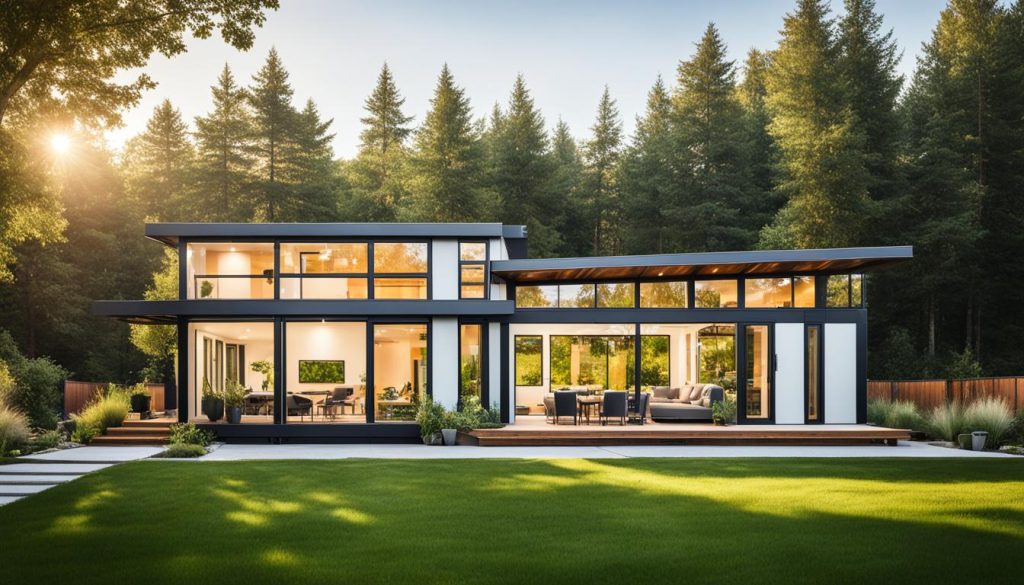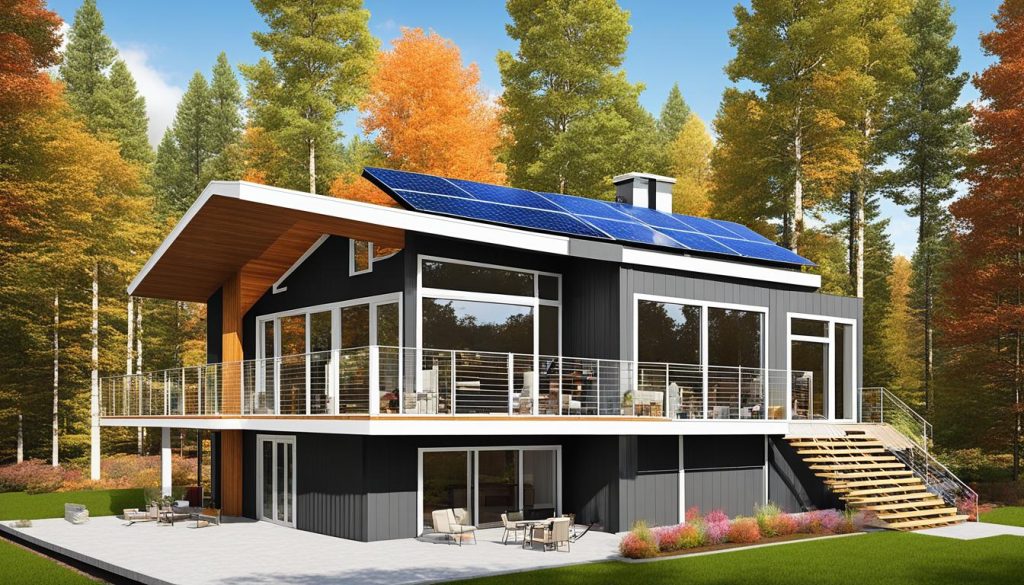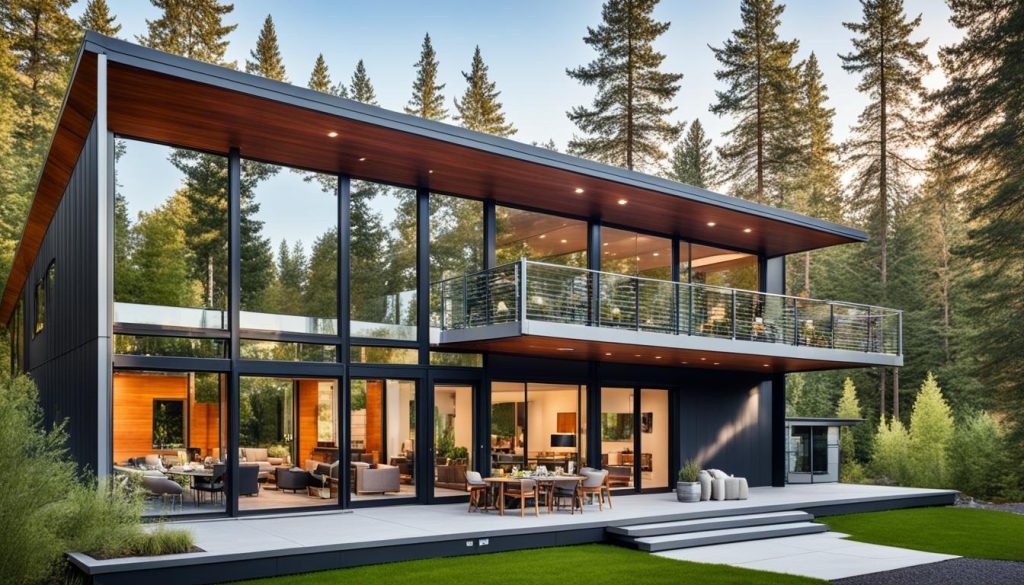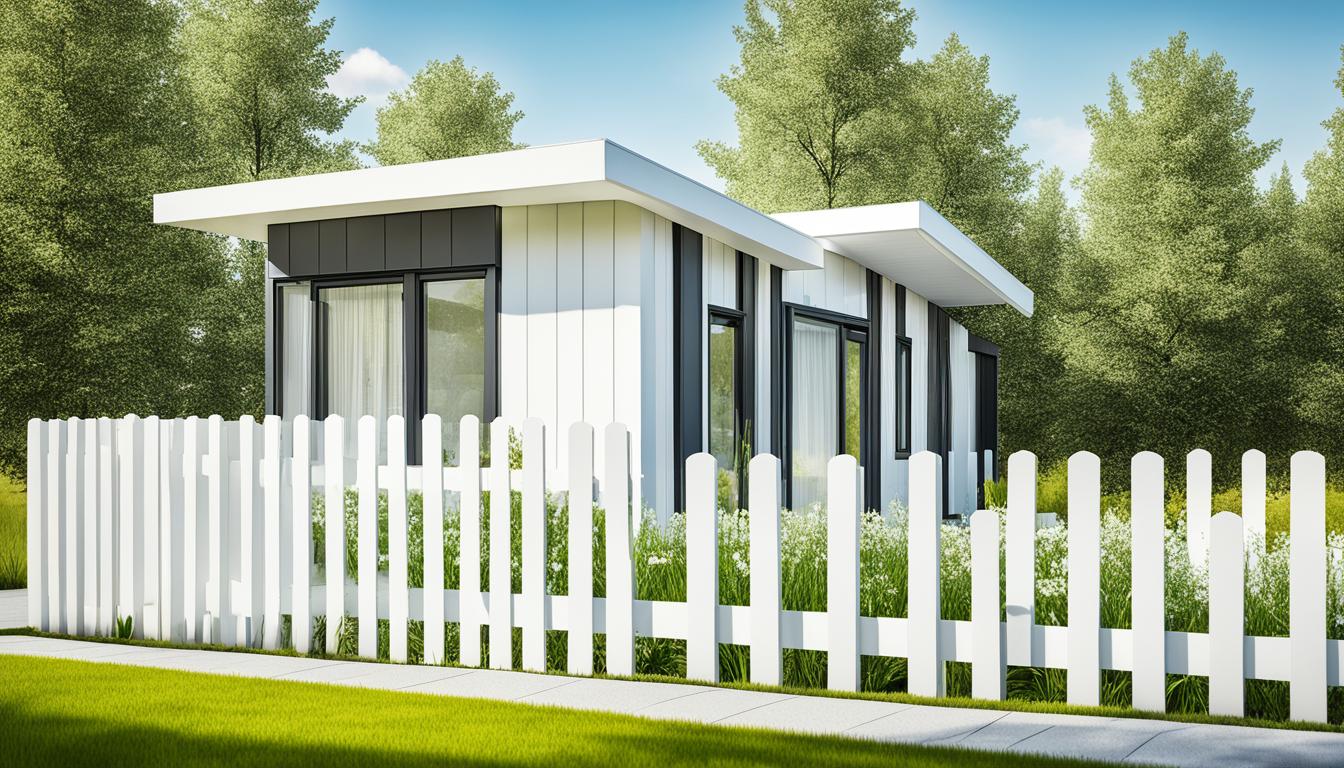The demand for prefab modular homes is rising. They offer cost savings and are good for the planet. It’s important to know the costs of prefab houses, modular homes, and prefabricated homes. This helps understand the investment in offsite construction dwellings.
Prefab modular homes are also known as panelized buildings or premanufactured residences. They are becoming popular for their cost benefits. These homes are a flexible, affordable choice compared to traditional homes, which can be very expensive.
Before looking into prefab modular homes, let’s compare them with traditional homes. We’ll see the benefits of factory-built homes. Knowing what affects the cost of prefab houses helps me make a smart choice that fits my budget and lifestyle.
Understanding Prefab Modular Homes

Building a new home can be tough, especially when choosing between prefab modular homes and traditional ones. Prefab modular homes are made in a factory and then put together at the building site. They have many benefits that make them a good choice for many people.
Prefab vs. Custom-Built Traditional Homes
Prefab modular homes and custom-built homes are built differently. Prefab homes are made in a factory and then moved to the site. Custom homes are built on-site from the ground up. This gives custom homes more personal touches.
Benefits of Prefab Modular Homes
- Faster construction timeline: Prefab modular homes can be built quickly, in weeks or months. This is much faster than building a custom home.
- Flexible designs: These homes come with many design options. This means you can pick a style that fits your taste and needs.
- Eco-friendly and energy-efficient: Many prefab homes are made to be green. They use less energy and are better for the planet.
- Weather resistance: These homes are built to handle different weather. They’re a good choice for homeowners who want a strong home.
- Cost-effective: Making prefab homes in a factory and building them quickly can save money. This makes them a smart choice for many people.
But, prefab modular homes might not have as many design choices. They also could face zoning issues in some areas. Knowing the good and bad points about prefab homes helps homeowners make a smart choice.
prefab house cost: An Overview

Prefab house costs can change a lot. They are usually cheaper than traditional homes, costing between $80 and $120 per square foot. But, the price can change a lot based on different things.
Factors Affecting Prefab Home Pricing
Many things affect the cost of a prefab home. The size, design, and how much you customize it matter a lot. Bigger homes with fancy designs cost more than small, simple ones.
Home Size and Design Complexity
The size of the home is a big factor in cost. Bigger homes with more stories cost more than small ones. Also, homes with complex designs cost more than simple ones.
Level of Customization
How much you want to change the home also affects the cost. Choosing a custom design costs more than a standard one. Custom changes can be small or full custom solutions.
| Factor | Impact on Prefab House Cost |
|---|---|
| Home Size | Larger homes are more expensive |
| Design Complexity | Intricate floor plans and custom features increase cost |
| Customization Level | Higher degree of customization leads to higher prices |
Modular Home Cost Per Square Foot
Looking into prefab house costs, modular home pricing is key. On average, prefab modular homes cost between $80 and $120 per square foot. This means a 1,600 sq. ft. home costs about $128,000 to $192,000.
For bigger homes, prices for a 1,800 sq. ft. prefab home are $144,000 to $216,000. If you want a huge home, 2,000 sq. ft. or more, expect to pay $160,000 or more.
Remember, these prices are just for the home, not the land it sits on. The cost can change based on how custom it is, its design, and the features you pick.
| Home Size | Prefab Modular Home Cost |
|---|---|
| 1,600 sq. ft. | $128,000 – $192,000 |
| 1,800 sq. ft. | $144,000 – $216,000 |
| 2,000 sq. ft. | $160,000 – $240,000+ |
Knowing the cost per square foot helps buyers plan their prefab house budget. It makes choosing the right size and features easier.
Additional Expenses to Consider
Planning the cost of a prefab or modular home means looking at more than just the home’s price. There are extra costs that can quickly add up. These are key to include in your budget for a prefab house or modular home pricing.
Site Preparation and Land Costs
Getting the site ready for your prefab or modular home can cost a lot. This includes clearing the land, making it level, digging for a basement or foundation, and planting trees and flowers. Costs can be between $1,250 to $4,000 or more, depending on the site.
Utility Connections and Permit Fees
Connecting your prefab home to utilities like electricity, water, sewer, and gas can cost $3,000 to $20,000. You also need to think about permit fees. These fees change based on where you live and the project’s details.
Knowing about these extra costs is key when planning your prefab, modular, or offsite home’s total cost. By looking at all these factors, you can make a realistic budget. This helps ensure a successful prefab home investment.
Luxury Prefab Homes: A Higher Price Point

Prefab houses are often seen as affordable. But, there’s a growing interest in luxury prefab homes in the US. These prefab house cost more but offer unique design, eco-friendly features, and top-notch craftsmanship.
Luxury Features and Finishes
Stillwater Dwellings is a top name in luxury modular home pricing in the US. Their prefabricated home expenses come with premium features. Think sleek kitchens with top appliances and spa-like bathrooms with luxury finishes.
These factory-built housing budget also include energy-saving tech. This means advanced insulation, solar panels, and smart home systems. These features make homes more sustainable and cut down on costs over time.
Stillwater Dwellings’ luxury offsite construction dwelling cost are between $100 to $150 per square foot. This depends on how customized you want your home to be and the features you pick. These panelized building price are for homeowners wanting a unique, high-end living space. They combine modern design with great craftsmanship and care for the environment.
If you like the idea of a modern cabin or an urban premanufactured residence investment, Stillwater Dwellings has many options. These industrialized homebuilding outlay offer a great alternative to traditional homes. They give you quality and personalization without the high cost of building a home from scratch.
These system-built abode expenditure make owning a luxury home more accessible. They offer a way to get a high-end home at a lower volumetric construction domicile affordability.
Financing Options for Prefab Homes
Buying a prefab or modular home can be expensive upfront. But, if you can’t pay the full prefab house cost or modular home pricing at once, there are ways to finance it. These options can help make your dream of an prefabricated home or factory-built housing come true.
Getting a traditional mortgage loan is a common way to finance. Many lenders offer modular home loans now. This makes it easier to get the money you need for the offsite construction dwelling cost and panelized building price. If you don’t own land, you’ll also need a land loan to buy it before building your premanufactured residence.
Looking into industrialized homebuilding financing is another good idea. These programs are made for system-built abode or volumetric construction domicile projects. They offer special solutions and can help make the process smoother for prefabricated home expenses and factory-built housing budget.
It’s key to talk to experts, like mortgage lenders, real estate agents, and construction pros, no matter which financing route you take. They can help you understand the premanufactured residence investment and industrialized homebuilding outlay better. With their help, you can pick the best financing for your prefab home project.
Advantages of Prefab Home Construction
Prefab modular homes have many benefits. They are quick to build and save a lot of money. Most of the work is done in a factory, so putting it together on-site is fast. This means homeowners wait less and save money compared to traditional homes.
Time Efficiency and Cost Savings
Building prefab homes in a factory makes the process quicker. This means you can move in sooner. You also save money because the project takes less time and costs less to build.
Eco-Friendly and Energy-Efficient Solutions
Prefab homes are good for the planet and save energy. They use solar power and have insulation and windows that save energy. These features are built into prefab homes, making them a green choice for living.

